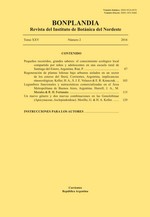Functional and nutraceutical legumes marketed in the metropolitan area of Buenos Aires, Argentina.
DOI:
https://doi.org/10.30972/bon.2521261Palavras-chave:
Functional food and nutraceutics, Leguminosae, Urban Ethnobotany.Resumo
In this work, we analyzed data from ethnobotanical surveys of functional and nutraceutical legumes (Leguminosae) commercialized in the metropolitan area of Buenos Aires, Argentina. The surveys took place in outlets of the general commercial circuit and the restricted circuits belonging to Bolivian and Chinese immigrants. We recorded the species, its products, local therapeutic uses, and available published data on biological activity and effects. Nineteen species were found: Arachis hypogaea var. hypogaea, Cicer arietinum, Glycine max, Lablab purpureus, Lens culinaris, Lupinus albus, L. mutabilis, Medicago sativa, Phaseolus lunatus, P. vulgaris, Pisum sativum, Prosopis alba, Tamarindus indica, Trifolium repens, Trigonella foenum-graecum, Vicia faba, Vigna angularis, V. radiata and V. unguiculata var. unguiculata. Most of these species (15) were found in the general commercial circuit, whereas the rest (4) only in the restricted commercial circuits of immigrants, including L. mutabilis, which deserves a wider diffusion. In most cases, the local uses assigned to a surveyed species correspond to the information available in the literature on the species’ biological activity and effects. This paper provides new insights for ethnobotanical studies and highlights the therapeutic relevance of legumes in the study area.Downloads
Não há dados estatísticos.
Downloads
Publicado
2016-07-01
Como Citar
Hurrell, J. A., Morales, M., & Fortunato, R. H. (2016). Functional and nutraceutical legumes marketed in the metropolitan area of Buenos Aires, Argentina. Bonplandia, 25(2), 115–128. https://doi.org/10.30972/bon.2521261
Edição
Seção
Artículos originales
Licença
Declaration of Adhesion to Open Access
- All contents of Bonplandia journal are available online, open to all and for free, before they are printed.
Copyright Notice
- Bonplandia magazine allows authors to retain their copyright without restrictions.
- The journal is under a Creative Commons Attribution 4.0 International license.















.jpg)


